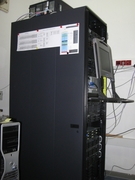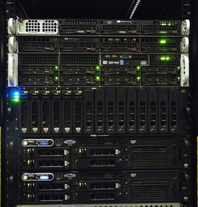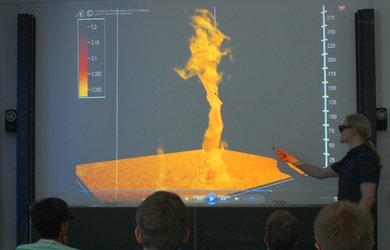Common



The institute has a well-equipped, modern IT infrastructure. In a small, air-conditioned server room, 11 servers are working, ten of which are operated under Linux. Half of the servers are needed for special meteorological tasks.
More than 60 workstations are equipped with PCs. In addition, there is a small pool room with 5 computers as well as printers and scanners. Approximately 15 measuring computers for controlling measuring systems and recording data and several laptops complete the IT infrastructure. All computers are wired in a structured way. For Linux computers, data and user information are stored centrally on one of the servers and backed up daily
NinJo Workstation



The NinJo Workstation program package is used for visualization and processing of meteorological data. It was developed by the German Weather Service, the Center for Geoinformation of the German Armed Forces, the National Meteorological Service of Switzerland, the National Meteorological Service of Denmark and the National Meteorological Service of Canada and is used internationally. NinJo Workstation is used specifically for training students in synoptic meteorology (weather forecasting). This program alone provides a daily network load of about 100 GB and holds about 600 GB of data.
NVIDIA 3D Technics



The seminar room of the institute is equipped with 3D Nvidia Vision technology. This makes it possible to interactively view computer animations such as the turbulent flow around buildings and vortex dynamics in the atmosphere using 3D technology.
GPU COMPUTER FOR PARALLEL COMPUTING
One of the institute's servers is equipped with two of the Nvidia Tesla K40 GPU graphics accelerator cards released at the end of 2013 and is located in the LUIS computer center (Leibniz Universität IT Services, formerly RRZN: Regional Computing Center for Lower Saxony), where it is also available to other researchers at the university. The PALM working group collaborates with employees of the compiler vendor Portland Group.
High Performance Computing



The North German Network for the Promotion of High Performance Computing (HLRN) operates one of the fastest massively parallel computers in Germany. The system with more than 56,000 processor cores represents an important contribution to the promotion of science and research in the northern German states. The HLRN-III consists of two identical Cray XC30s, which are located at the RRZN (Regional Computing Center Lower Saxony) in Hannover and at the ZIB (Konrad Zuse Center) in Berlin. One of the main users of the HLRN-III system is the Institute of Meteorology and Climatology, which uses the supercomputer for computationally intensive simulations of the atmospheric boundary layer on several thousand processor cores (see PALM working group).


